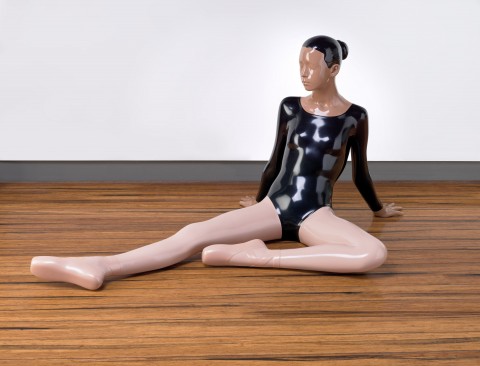SONG OF THE FROG, 2006
MICHAEL PAREKOWHAI
fibreglass and two pot paint
180.0 x 70.0 x 70.0 cm
Roslyn Oxley9 Gallery, Sydney
Private collection, Sydney
The Promised Land, Queensland Gallery of Modern Art, Brisbane, 28 March – 21 June 2015
Roslyn Oxley9 Gallery, Sydney Contemporary 2015, Carriageworks, Sydney, 10 September – 13 September 2015
In 1968, the year that twentieth century art ‘influencer’ Marcel Duchamp died in France, contemporary artist Michael Parekowhai was born a world away in New Zealand. At art school the young Parekowhai avoided the prophesies circulating on the ‘death of painting’, instead tuning into sculpture and installation. He relished the open-ended dialogue with his audience that occurs when a ‘readymade’ is thrust into the gallery. Whereas Duchamp as Dadaist elicited readymades to undermine high-art’s privileged position, Parekowhai as impresario concentrated more on ‘made’ than ‘ready’, in a way that curator Natasha Conland describes as ‘a canny ability to make everyday objects do painless visual acrobatics, with a soft and often beautiful landing’.1
In a manner that we have become familiar with through mega-artist Jeff Koons, Parekowhai’s Song of the Frog, 2006, is an editioned and polished piece. But there the comparison stops. Where Koons may take us on a fast ride in a shiny new car, with a definite intention to sell it to us, Parekowhai slows us down as he puts more questions and cultural contradictions in our path. As a Māori man of Ngāti Whakarongo descent, his works speak to biculturalism. Yet often these references are quietly implied and are devoid of parochialism, allowing his sculptures a place in any museum in the world—right alongside Koons and Duchamp.
In making the Song of the Frog series of works in 2006 with his team of two pot polyurethane finishers, Parekowhai creates ballet dancer porcelain figurines on a larger-than-life scale. The figurines as source material (the readymade) embody that classical sense of young female beauty: poised and elegant. However, in Parekowhai’s hands, his young Māori women have a pervading sense of vulnerability. In the case of the current work, even while the figure is seated with strongly supporting arms, the legs are akimbo and the body remains vulnerable. When an example of this work was shown in Parekowhai’s retrospective The Promised Land at the Gallery of Modern Art in Queensland in 2015 it was installed amid a brace of pick-up-sticks the size of spears pointing threateningly at the now very vulnerable seated figure.
Such games are to be taken seriously. Parekowhai is fascinated by childhood recollections: what would it have been like for a young Māori girl, perhaps a little sister, even, to take part in a ballet school of the suburban white middle class? In asking this question, the viewer is not hectored with Māori slogans that many of his 1990s contemporaries used to bridge the bicultural divide. That is not to suggest that the work isn’t powerful, for the very title implies a sound that can fill a space and a movement of akimbo limbs to create dance. When Parekowhai showed an intricately carved piano at the Venice Biennale in 2011, curator Justin Paton questioned: ‘Will visitors hear the piano from a distance and find themselves drawn in by the sound?’2 Indeed they were. The piano was continuously played and the sound filled the palazzo. When Song of the Frog meets our gaze, we are initially struck by its stillness until an infectious sense of dance takes over; Parekowhai would surely choose Tchaikovsky’s Swan Lake to allow his Māori maiden to spring to life as princess Odette, and move on point to centre stage.
1. Conland, N., ‘On Show’, Exhibitions and Events at Auckland Art Gallery Toi o Tāmaki, Issue 12, 2009, p9
2. Paton, J., ‘Weighing in, lifting off Michael Parekowhai in Venice’, On First Looking into Chapman’s Homer, Michael Lett and Roslyn Oxley9 Gallery, Sydney, 2011, p. 27
PETER JAMES SMITH
